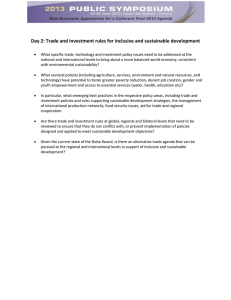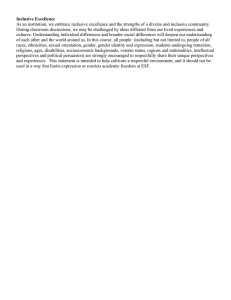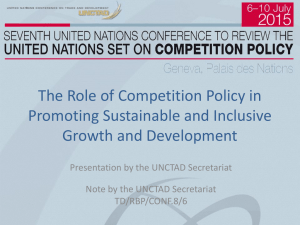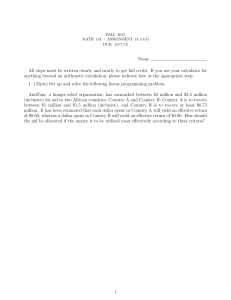Document 12693661
advertisement
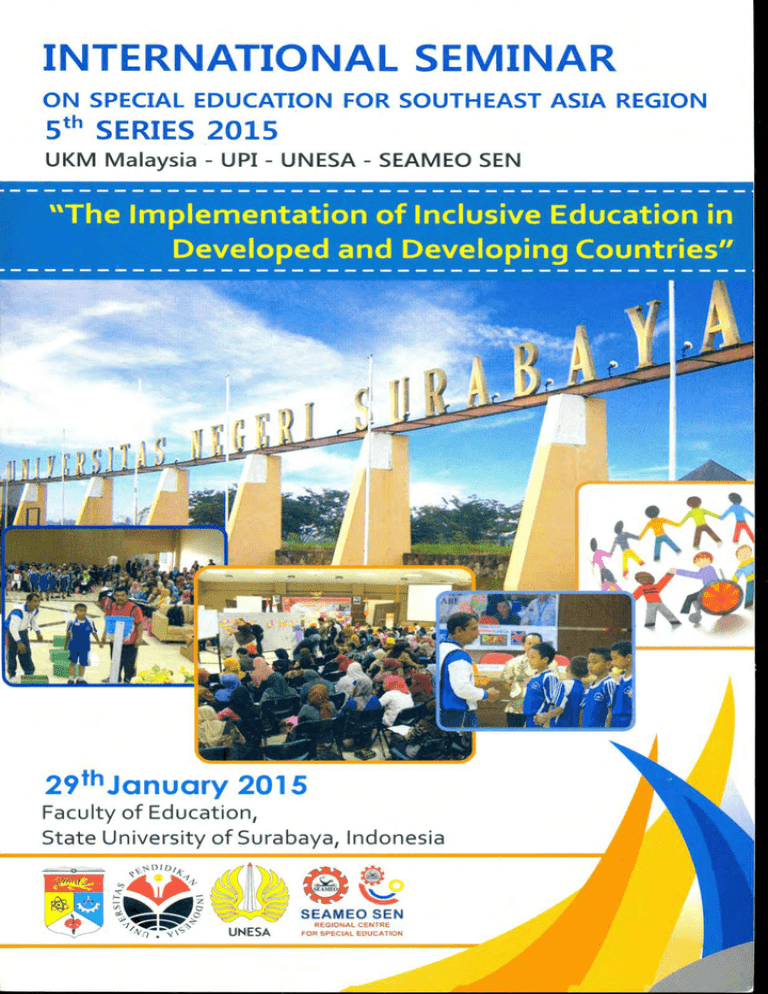
THE ROLE OF INSTRUCTIONAL SUPERVISIONINIMPLEMENTATIONINCLUSIVEEDUCATIONPOLICY By: Hermanto Special EducationDepartmentof Yogyakarta State University e-mail: hermansp@uny.ac.id& HP. 08121575726 Abstract The inclusive education is one way to provide the right education for children with special needs (ABK) as learners. As we known in 2014, Yogyakarta province at least1,926 crew members still have yet to get access to education from 9,096 ABK school age. Of the number of crew members of the school age, 4,782 to follow education in special schools, and 2,388 crew learning in inclusive schools spread across 350 schools. Based on these data, the involvement of an inclusive school in the province to accommodate learners with special needs (PDBK) is quite responsive. Indicators of the success of inclusive education is certainly not how many schools organizers and how many students with special needs who enrollin inclusive schools. How does the school provide comfort and accessto the widest PDBK is an important factor that must be considered. Do not let school only physical move crews to regular school without giving rights as the principle of inclusive education. In reality to change the paradigm and habits of teachers in learning to differentiate because of PDBK is not an easy problem. In an effort to support the successful implementation of the inclusive education policy, it is necessary to study the role of supervision. The instructional supervisionis the professional assistance by the principal as a supervisor for teachers in order to increase the quality of learning is done. One approach that can be used is a clinical approach. Through intensive supervision and learning through coaching given the principal, then the learning difficulties faced by teachers can be resolved. Thus inclusive education schools area ware of the importance of cooperation between 1 teachers and principals who ultimately can affect and impact the school community. Keywords: instructional supervision, policy implementation, inclusive education Introduction The educational services for children with special needs there are many forms and styles. In general, the education service model can be categorized into segregation groups or inclusive. Where segregation models are models of educational services for all children with special needs are given exclusively in one group, while the model is a model of inclusive education services that provide space and opportunities for children with special needs have the opportunity together with children in general in a classroom or in a school. According to Samuel A. Kirk (1986), mentions that means that the model of special education services ranging from regular school full (least restrective environment), regular school with a teacher consultant, regular school with itinerant teachers, regular school with the source chamber, regular school part- time, a special class but in regular schools, special schools daily, boarding schools, and resedential institution. Kirk at that time did not call it a school inclusive but is better known as a model meanstreaming. Similarly, Hallahan and Kaufman (2006) has provided an explanation of the form of the provision of education for children with special needs ranging from regular classes with regular teacher, a regular classroom with a consultant, regular class with itinerant teachers, resource teachers for regular classes with regular teachers but one time a child was in the room with the resource teacher resources, diagnnostic center - prescription, education at home or in hospital, special classes in regular schools with the teachers, special schools without boarding, and special schools with boarding. Of the various models is of course each has its advantages and disadvantages depending on the condition of children with special needs education systems and policies in force and applied in one place or country. Of 2 course, the higher consciousness of a society, the openness of access to education for children with special needs would be better anyway. In line with the consciousness of the world will be education for all, dynamics and attention to the education of children with disabilities are increasingly good specially. Similarly, in Indonesia, in line with existing policy, attention to children with special needs the better. Starting from an integrated education as a form of service in addition to segregation, and is now headed to the awareness of inclusive education. Since the issuance of the regulations of national education minister number 70/2009 on inclusive education, inclusive schools was increasing rapidly. In fact the number of districts/cities or provinces which declared as an inclusive city district, it is growing too inclusive school opened. One of the province than declaration of education inclusiveis Yogyakarta Province. The facto Yogyakarta Province declaration education inclusiveon December 12, 2014. The DIY Province is a eleventh province which declared inclusive education. However, long before the declaration of inclusive education, especially in the city of Yogyakarta Province has started inclusive education with strengthened regulation mayor in 2008. In order to provide care and educational opportunities for children with special needs, Yogyakarta Province also has spawned a number 4/2012 regulation of protection and fulfillment of the rights of persons with disabilities. This regulation is of course a form of attention and accommodating of the Law of the Republic of Indonesia number 19/2011 on the ratification of Convention On The Rights Of Persons With Disabilities. Thus legally inclusive education in the province can be said to be strong, because there are legal footing as national, provincial, city and district level. With the support of regulations that strengthen inclusive education services or otherwise that is the fact in schools that require regulation, the development of the school and students are getting education in inclusive schools really growing. Even to support inclusive education in the province is now hiring a companion of special schools for the smooth running of inclusive education. The number of accompanying teachers currently amounts to 400 teachers who are appointed from a special school. The presence of specific guidance teacher (GPK) would be very 3 helpful in inclusive schools, but attendance and limitations of specific guidance teacher (GPK) certainly cause less than the maximum in inclusive schools. To overcome all that, it is necessary to build awareness, skills of the school 's own internal party both teachers and principals about learning strategies in inclusive schools. As teachers and principals have a lot to get a variety of inclusive education workshop organized by the government, the training course can be beneficial for the school. The various workshops for principals and teachers have often done, but the post- training follow-up less than optimal. Many teachers and principals who have not made the real action in inclusive schools. This is attributed to the difficulty of changing the outlook and habits of teachers in learning, also still many obstacles caused by the sometimes contradictory regulations. As a result, many teachers who have yet to develop the program, implement and evaluate learning as they should be in the inclusive classroom. In addition, the teachers themselves still feel confused provide education in inclusive classes should be. The role of the principal is also not maximized despite having received training on inclusive education. Training materials for school principals have not come to training and technical assistance strategy. Aware of the problems in the field, that the success of the implementation of inclusive education policies, the real role of the principal can be further optimized by means of clarifying one of the principal tasks is instructional supervise. Principals, people close to the teachers have many opportunities to discuss, direct learning to do the teacher so that the quality of learning and achievement of learners can be increased. The role of the principal as an instructional supervisor in an effort to improve the quality of learning in schools inclusive can be pursued. With the awareness of the principal in providing insight and inclusive learning strategies that will spur teachers to be more willing to explore a variety of techniques and learning strategies in inclusive classrooms. Furthermore, in this paper discussed the role of instructional supervision in the implementation of inclusive education policies. The Inclusive Education, Openness Access for Children with Special Needs 4 The children with special needs in Indonesia is not easy to establish with certainty. This is because there are many different points of view and the criteria used to describe and define as children with special needs. Similarly, interdepartmental use different terms with a certain purpose and intent as well. Social departments for example, is still calling children with special needs in terms of children or disabled. Mention will certainly affect data collection will definitely extent and nature of children with special needs. However, when referring to the estimate of the world that is in a normal curve, the average child with special needs achieve the range of 2.5-5 % of the population. Thus in Indonesia canpredictable number of children with special needs are not much different from the predictions of the world. What if not addressed, then it will also be able to reduce the success rate of compulsory education and literacy programs. The difficulty of enforcing or diagnose children with special needs in Indonesia, particularly in children with special needs who have barriers and needs in addition to the physical factors. If this categorization is caused by abnormalities of the physical condition, it is relatively easy to detect and categorized in the group of children with special needs. Of course, very different in determining whether a person is classified as special needs or not caused by social or mental factors. How we can find out easily if the person with special needs as they often have difficulty learning, course required special skills. The difficulties caused by the level of public understanding will not equitable understanding children with special needs, especially those caused by social and mental factors. Regardless of certainty the number of children with special needs nationally, or in an area, but certainly children with special needs is not all gain access to decent and adequate education. Many factors cause has not gained access to education for children with special needs. Whether we realize it or not, the number of special schools that exist today have not been evenly distributed. Not necessarily in one district there are special schools, thus resulting in not all children with special needs have the opportunity of education. Awareness of parents who have children with special needs to have their children are getting better. Although the parents of children with special needs are already aware of and willing to send their children, because the schools are far then it probably 5 does inhibit and discourage parents to send their children with special needs with a variety of reasons. For decades, education services for children with special needs in Indonesia that many developing is a special school model or models of segregation. Where segregation models have many disadvantages compared to the benefits. One factor that must be recognized weakness is the infrastructure that must be provided. With the number of students with disabilities are very limited, but land acquisition or physical buildings can not be avoided. In addition, the distance between learners stay with the existing school pretty much average, requires transportation, and sometimes troublesome parents, especially the weak economy helped. For that, thinking to find a solution on how to give the right to education for children with special needs in order to gain access to education continues to evolve frequently with awareness education for all. If the models segregation or special school is less provide opportunities for children with special needs, the inclusive education is one of the access that can be used as one of the pathways to education for children with special needs. Of course to be able to follow an inclusive education should be preparation and requirements that must be met by a prospective learners with special needs as well as by the school as education providers inclusive. With the requirements and criteria, it will not necessarily every child with special needs will automatically be able to follow education in inclusive schools. With so children with special needs who have not or do not meet the requirements in inclusive schools can enroll in a special school. The implementation of inclusive education is very dependent on the readiness, awareness, and support from various parties. Thus there is some form of inclusive education that can be selected and run by the school. Does the school will hold absolute inclusive education, or inclusive partly depends on school readiness. Schools may choose depending on the condition and readiness to provide specialized services to children with special needs in the regular school. Does the school will categorize learners with special needs in a class of its own or in a group would be correlated with the comfort and tranquility of learners with special needs and may also be other students. Whatever the form of services that 6 will be provided in inclusive education, whether in regular classes without support, or regular classes as a part - time basis and in a special class (Hegarty, 1981), but that is obviously going to be a way of inclusive education for children with special needs to get educational opportunities. Regardless of the quality of educational services provided to students with special needs in inclusive schools. But in fact the presence of inclusive education policy, many children with special needs the opportunity to participate in education. In the province for example, of the 9,096 school-age children with special needs who have the opportunity to enroll in an inclusive school as much as 2,388 children with special needs who are scattered in 350 schools. Similarly, in Gunungkidul of 2,128 children with special needs or disabilities, as many as 1,914 people have attended the course in inclusive schools, thus expanding access to education regents asked children with special needs (Source KR, 2014). With the opening of access to inclusive education is to make children with special needs that were not covered by the special schools are becoming increasingly underserved. Next is the strengthening of the philosophical aspects of the school that inclusive education is not only special needs children move from school to school inclusive. The Reality of Implementation Inclusive Classroom Before discussing the role of instructional supervision in the implementation of inclusive education policy, it is necessary first described in the subtitle that discusses how teachers prepare learning, implement and evaluate learning or how management class that teachers in inclusive classrooms. This fact to reinforce how current conditions, between the interests of the needs of the field, the intensity of the training and the success of inclusive education. To implement inclusive classroom learning much prepared. Start of preparation of learning that can accommodate all the interests of the students in the class, differentiated learning preparation, implementation of learning modification, to bring classroom atmosphere to life, the arrangement of space accessible to all learners, and so on all the small parts that must then be teachers in inclusive classrooms. For that, although not in detail discuss about reality from the preparation, implementation 7 and evaluation of inclusive learning, but the condition of this field can give an idea. One of the primary schools of inclusive education in Gunung Kidul is Ngeposari II Elementary School, this school is located at Mojo, Ngeposasri, Semanu, Gunung Kidul inclusive education since 2008 on show from the education department. The school has 42 students with special needs and scattered in all classes. Elementary Schools Ngeposari II is led by Romdloni, S.Pd. Based on observations and the results of the data collection instruments that have been carried out, this school has not done much in the success of inclusive education efforts. In planning learning, teachers are still setting up learning in the regular classroom as average condition and ability learners alike. Many obstacles and reasons behind teachers have not done the preparation and implementation of inclusive education. Conditions learning implementation is at least recognized and strengthened by the experience one of the teachers that Evi Setyowati that inclusive learning done in school is not maximized. Implementation of learning in elementary Ngeposari Gunungkidul such, SD Jolosutro Piyungan Bantul who has organized an inclusive education since 2002, and has 35 learners with special needs students are not much different. Of the number of students with special needs are scattered in class I have 5 students, there are 3 students of class II, class III there are 6 students, grade IV there are 8 students, the class V there are 5 students in the sixth grade and there are 7 students. This school has a GPK assisted over two days in every week. This school has often receive training on inclusive education. In learning, the school has organized the classical learning and providing learning services individually. Nevertheless, the facts in the classroom, the teacher has not been optimally arrange learning program with individualized learning principles should be. In the implementation of learning turns individual learning is meant to provide tutoring or extra lessons outside school hours and has not been programmed in preparation for the integration of learning and teaching practices in the classroom. Based on the results of preliminary research conducted in elementary school inclusive education providers, although the school has been referred to as an inclusive school but apparently in the process of learning that do still use regular 8 learning model as usual. Based on the research findings, teachers still have doubts in identifying students with special needs. Even if they already know when one of their students with special needs, teacher often experience confusion in planning learning differentiate between to accommodate learners with special needs students in general. Another factor that affects several unsuccessful teachers prepare and conduct an inclusive learning models applied because the school directly applied in full inclusive model that learners with special needs coexist in the same class with regular students. As the process towards inclusive education, provision of special classes will be help teachers understand learners with special needs and to plan and implement an inclusive classroom. The Role of Instructional Supervision in The Inclusive Education Implementation There are several options that can be done in a regular school setting up and implementing inclusive education in support of inclusive education policies that have been initiated by the government. As mentioned above, in implementing inclusive education schools can choose to use a special class of models to accommodate students with special needs in regular schools. Inclusive education model with a special provision in the regular school classes do exist advantages and disadvantages. As the process towards inclusive education, the presence of this particular class will be easier for teachers to learn to recognize students with special needs, in addition to learning arrange a time when the program must be drawn in the form of fully inclusive. Stages and special class of models is only one way, another way to escort and the success of inclusive education course there are many ways that can be done. In addition to selecting the model according to the condition of the school , other possible ways can be done in an effort to achieve the success of inclusive education is to optimize the role of the principal. Principals, especially in primary schools generally have quite a lot of time in school. Principals in supporting the successful implementation of inclusive education policy by highlighting the role as supervisor of learning. In the world of education, supervision refers to the business or activities to improve the learning process. Glickman (1981) mentions that the supervision of learning is a series of activities to help teachers develop 9 their ability to manage learning in order to achieve learning objectives. Keywords in supervised learning is certainly not the function of oversight but rather to help teachers to improve learning. With the help of intensive conducted with full transparency between teachers and principals will produce planning and learning process quality as well . So basically learning supervision function is to promote and develop learning. The role of the supervisor (Oliva, 1984) is a coordinator, consultat, ruler of the group, and as an evaluator. In theory supervision, supervision rests on the principle that recognizes that every human being has the potential to flourish. For that, a good supervisor would understand his role as the person in charge and responsible for assisting teachers in improving learning, ranging from the process, implementation, and the evaluation. The role of the supervisor should seek to coordinate programs and materials needed to improve teacher performance. As a consultant, the supervisor should have the ability and a strong understanding of curriculum, instructional methodology, staff development to help teachers either individually or in groups. As of this moment, the dynamics of the curriculum in 2013, then the principal must be able to provide solutions or explanations to the teacher, or educational issues at this time. As a group leader must be able to create a good group dynamics. The school principal as a supervisor with the role as evaluator should be able to help teachers to evaluate the implementation of learning and curriculum, can help identify the problems faced by teachers, help conduct research and development in learning. Supervision of learning has an important role. As noted Alfonso that the behavior of student learning (learning behavior) is heavily influenced and determined by the behavior of the teacher teaching (teaching behavior), while teaching a behavior is determined by the behavior of the supervisor (supervision behavior). However, in order to supervise the study can serve as better then three terms as expressed Glickman (2009) knowledge, interpersonal skills, and technical skills must be completely owned by a supervisor. Supervision of learning is the professional assistance provided by supevisor to teachers in order to improve professional skills, especially the ability to teach. Teaching and learning, where teachers and students interact, become a central service learning 10 supervision. Therefore supervised learning has an important and strategic role in improving the quality of teaching in schools. The role and function of supervision is very important lesson, which self-awareness for the evaluation and correction is not a necessity, it becomes an important supervisory role. In an effort to support the implementation of inclusive education policies, the role of the supervisor in learning should be strengthened. In the implementation phase of supervision in inclusive schools, many approaches that can be used or selected. One approach that can be used is clinical supervision. Clinical approach is a face to face meetings between supervisors and teachers to discuss the things taught in the classroom in order to carry out the repair process of learning and professional development. The underlying assumption of supervision by clinical approach is learning a complex activity, therefore, the components can be isolated so that learning becomes isolated learning. Clinical supervision is a model professional assistance given to teachers through a systematic cycle in the form of planning, careful observation, and giving feedback on performance of teachers in the classroom teaching. Clinical supervision is done collegially between principals and teachers. Through this collegial relationships or the quality of learning that accommodates all students can be improved, what face and felt the teachers in inclusive classrooms can be discussed, and planned repairs together. As in the clinical supervision theory, then at the time of implementation of instructional supervision to uphold the role of supervision, three important stages in clinical supervision must be started early meetings, observation of teaching, and gathering feedback. At the stage of the initial meeting, teachers and supervisors alike to meet in an intimate setting and open with each other. At this stage, the teacher suggested open to all matters relating to learning, and supervisors should establish a collegial relationship. At this stage of the case discussion and look for a solution, then poured in lesson planning. Thus teachers feel safe and confident to plan inclusive classroom. To that end, the teacher as most people know and feel the problems of inclusive classes should be really pleased to open the issue. Thus the results of the discussion and problem-solving program that can provide usefulness when applied in teaching. 11 In the implementation of clinical supervision in an inclusive school, the teacher must make sure that the existing supervisor faces do not mean to find fault but to improve teaching. The final target initial meeting was a teacher and supevisor have agreement on what is to be observed and corrected. The headmaster at this stage need to understand the rules and the various activities that must be undertaken to support the success of supervision. If the initial meeting has been performed, which is followed by classroom observation, that the teacher did accentuate the look of learning the skills that have been agreed in advance. As teachers teach, supervisors do the observations of the teacher in the learning process. Supervisors use observation instruments that have been developed jointly at the previous stage. In action this observation, to obtain complete results, it can be used tools such as tape recorders and the like. During these observations, the active supervisor to observe and examine how learning teachers. Suitability or unsuitability of the planned learning is material for discussion reversal. Thus if since the beginning of the learning planning, learning implementation, and evaluation of learning in inclusive classrooms do mentoring (coaching) by principals through its role as supervisor of the implementation of inclusive education policies will be able to be successful. Conclution The number of training on inclusive education has yet to be a guarantee of success of the implementation of inclusive education policies. In the implementation of inclusive education was not as easy as discussed in various training. Because there are still many obstacles or barriers, then one of the principal tasks that can be utilized and optimized to support the implementation of inclusive education policy is the duty of the principal as supevisor. Instructional supervision is the professional assistance by the principal as a supervisor for teachers in order to increase the quality of learning is done. One approach that can be used is a clinical approach. Mentoring teachers since the beginning of the meeting, scrutiny when learning is done with full disclosure will greatly support the successful implementation of inclusive education policies. Supervision intensive study conducted by the principal will greatly assist teachers including to 12 build teacher confidence. Through intensive supervision makes the obstacles and difficulties faced by teachers in inclusive classrooms will be quickly resolved. Reference Alfonso, R.J. Firth, GR. Dan Neville, RF. 1981. Instructional Supervision: A Behavior System, 2nd.ed., Boston: Allyn and Bacon. Balli, Sandra J. 2009. Making A Difference In The Classroom: Strategies That Connect With Students. Lanham: Rowman & Littlefield Education. Bishop, Kay and Cahall Jenny. 2012. Positive Classroom Management Skills for School Librarians. Santa Barbara: Libraries Unlimited. Cangelosi, James S. 2014. Classroom Management Strategies: Gaining and Maintaining Students’ Cooperation. 7th edition. United States: John Wiley & Sons, Inc. Davys, Allyson & Beddoe, Liz. 2010. Best Practice in Professional Supervision A Guide for the Helping Professions. London: Jessica Kingsley Publishers. Denis & Ny. Enrica. 2006. Inklusi, Sekolah Ramah untuk Semua. Terjemahan Mohammad Sugiarmin & MIF Baihaqi. Bandung: Nuansa. D’Amico, Joan and Gallaway, Kate. 2010. Differentiated Instruction for the Middle School Science Teacher Activities and Strategies for an Inclusive Classroom. San Francisco: Published by Jossey-Bass. Fleming, Ian and Steen, Linda. 2005. Supervision and Clinical Psychology. Theory, Practice and Perspectives. New York: Brunner-Routledge. Foreman, Phil . (Editor). 2008. Inclusion In Action. 2nd. Ed. South Melbourne: Thomson. Fox, Jenifer & Hoffman. Whitney. 2011. The Differentiated Instruction Book of Lists. San Francisco: Published by Jossey-Bass. 13 Fuller, Richard G. Kuhne, Gary William, and Frey, Barbara A. 2011. Distinctive Distance Education Design: Models for Differentiated Instruction. Hershey PA: Information Science Reference (an imprint of IGI Global). Glickman, Carl D., Stephen P. Gordon, dan Jovita M. Ross-Gordon. 2004. Supervision and Instructional Leadership a Development Approach. Boston: Pearson Ed. Inc. Gordon, Stephen P. & Glickman, Carl D. 1984. Applying Developmental Supervision: Tactical and Strategic Dimensions. Thershold in Education, Vol. 10 (2), halm 24-26. Hallahan and Kauffman. 2006. Exceptional Learners, Introduction to Special Education: New York: Pearson. Harris, Ben M. 1985. Supervisory Behavior in Education. Prentice Hall, Inc., Englewood Cliffs, NJ. Hermanto, dkk. 2012. Pengembangan Model Pengelolaan Kelas Penyelenggara Pendidikan Inklusif Tingkat Sekolah Dasar di Provinsi Daerah Istimewa Yogyakarta.Yogyakarta: Laporan Hibah Bersaing. Imron, Ali. 2011. Supervisi Pembelajaran Tingkat Satuan Pendidikan: Jakarta: Bumi Aksara. Jones, Vern & Jones, Louise. 2012. Manajemen Kelas Komprehensif, edisi ke-9. Terjemahan oleh Intan Irawati. Jakarta: Kencana Prenada Media Group. Kedaulatan Rakyat. 26 Desember 2014. Bupati Minta Perluas Layanan, hlm, 3. Kedaulatan Rakyat. 19 Desember 2014. Pemkot Didesak Susun Perda, Disabilitas Butuh Perlindungan Regulasi, hlm, 9. Kedaulatan Rakyat. 13 Desember 2014. DIY Deklarasikan Pendidikan Inklusi, hlm, 11. 14
